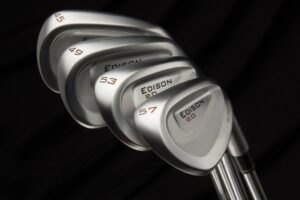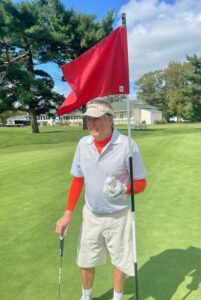Edison Wedges
October 20, 2023
Terry Koehler has a thing about wedges.
As he put it, “If you make a reasonably decent shot, you should see some reasonably decent results” – but from his perspective, that is not easy to do with most wedges, especially compared to other clubs, such as drivers.

Edison 2.0 wedges come in a variety of lofts
The longtime golf equipment designer, in business for over three decades, says even tour pros struggle to land 90-yard wedge shots within 30 to 50 feet of the intended target. Weekend TV broadcasts focus their coverage on the best performers each week, and therefore skew our perception of reality.
Koehler analyzed over 60,000 wedge-fitting profiles. That work led to his firmly expressed opinion about the source of the problem – the relatively unchanged design of wedges since Gene Sarazen added a gob of solder to an old niblick (9-iron) to help him compete in the 1932 British Open.
“The wedges are the most finicky clubs in the bag,” he said. “The tour pros can, with a lot of practice, create a penny-sized spot between the second and fifth groove up from the bottom. The rest of us usually hit the ball three to four grooves higher.” The ball flies high and usually short when that happens, because energy transfer at impact is reduced.
Koehler said the average wedge face hitting area for amateur golfers is the size of a 50-cent piece. That leads to significant distance and direction disparities from shot to shot. Regular wedge design cannot “forgive” those mishits.
His newest designs, now offered by Edison Wedges, moved the club’s weight distribution and sole features to improve the prospects for better results. In product testing from 90 yards out the Edison models dispersion pattern shrunk down to 21 feet, Koehler said.
The design process moved a portion of the clubhead metal from the hosel to the middle of the club face. Additional metal came from thinning the sole.
Placing more grams above the central impact point created a lower, penetrating flight, with more backspin and especially more consistent distance.
The numbers as noted at the Edison website are impressive – up to 38% more spin, launching 2 to 4 degrees lower.
The wedge design also relies on a past Koehler invention sometimes called the dual sole.
Shaped like a v, it features a high bounce angle in front and a low bounce angle in back. He said the combination gives golfers the best set of options, especially for those who set their wedge faces in different locations depending on the shot required.
Koehler said the combination improves turf interaction through impact while protecting golfers from “shoveling” the edge of the club into the ground.
Koehler said players might need some practice sessions to dial in their performances with the Edison models. They should be prepared to see the ball carry a bit farther but also spin and stop a bit faster.
Koehler sent me a set of his Edison 1.0 wedges, set at 49, 53, and 57 degrees, with KBS 80-gram graphite shafts and my preferred midsize grips.
I needed a few sessions to learn how these wedges perform compared to what I previously used. Part of that adjustment may have been due to the lighter shafts.
Out on the course, I could see a somewhat lower flight, but the real difference came when the balls landed. I learned I should plan for a longer carry because the balls stop more quickly after the first hop, especially with the 53- and 57-degree clubs.
Both wedges are fine out of the bunker. However, I only use the 57-degree wedge when I am short-sided with a steep slope to pop over.
Whether with full or partial wedge shots, my results also seem tighter, both in distance and right/left dispersion. The combination has also led to more birdies – not that I should be on the senior tour, but still a pleasing result.
Edison 2.0 wedges, the newest iteration, came to the market this spring. They feature a bit more cavity-back elements than the previous model. “We already had our revolution, so now we’re into evolution,” Koehler said.
The wedges are available at EdisonWedges.Com, and can be bought in singles or in combo sets with a variety of loft options. The company will also sell just the club heads for DIY club fitters.
College golf returns to Cape Region
The University of Delaware’s women’s golf team is once again hosting the Lady Blue Hen Invitational at Rehoboth Beach Country Club Oct. 21-22.
The teams expected to compete include UD as well as the Delaware State University Hornets.
Spectators are welcome, with cart rentals limited to those with medical conditions or a handicap access pass.
Baker’s first ace

Ted Baker
Congratulations to Theo (Ted) Baker for his first-ever hole in one, made Sept. 27 at Hooper’s Landing.
The avid Cape Region golfer used an 8-iron on the par-3 18th hole, from 126 yards.
Dallas Winslow, Jan Freeman, and John Coleman watched it happen.
In a very nice gesture, the Hooper’s Landing staff presented Baker with a pin flag Oct. 11 to note the occasion.

